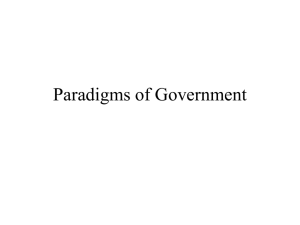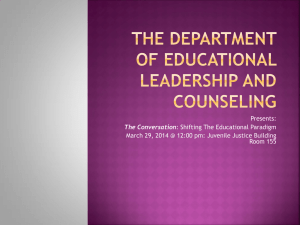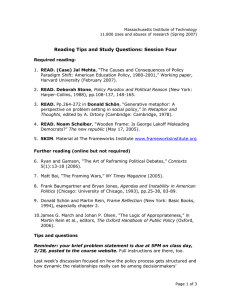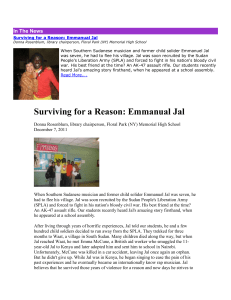11.800, Knowledge in the Public Arena: The Uses and Abuses... Professors Xavier de Souza, Frank Levy, and Martin Rein
advertisement
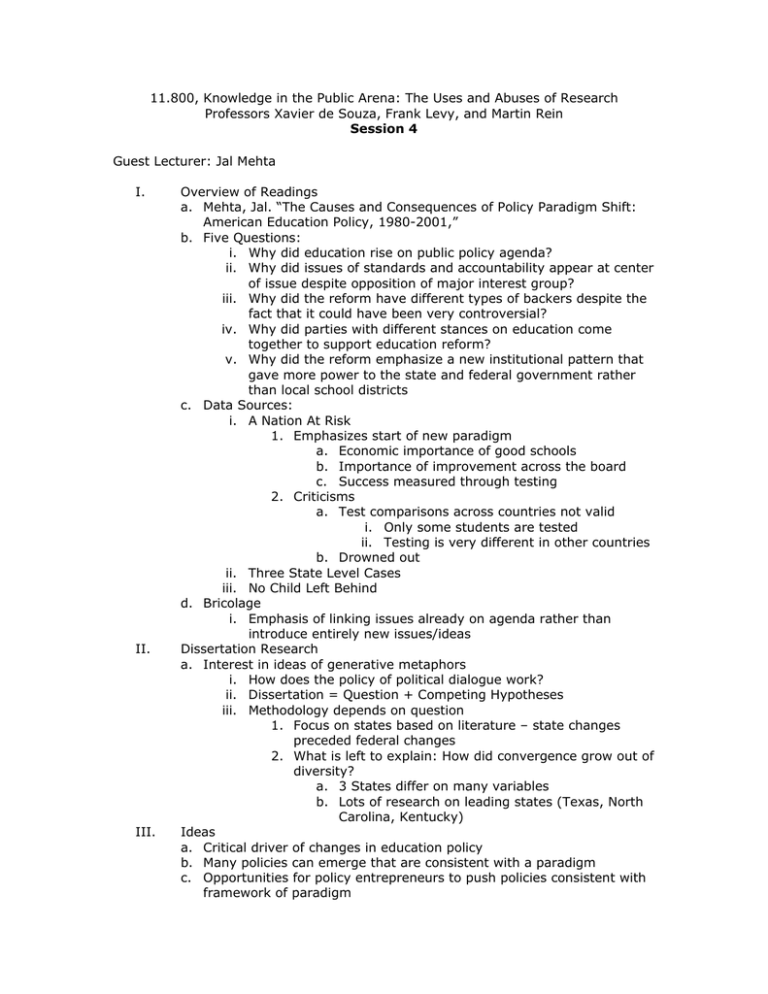
11.800, Knowledge in the Public Arena: The Uses and Abuses of Research Professors Xavier de Souza, Frank Levy, and Martin Rein Session 4 Guest Lecturer: Jal Mehta I. II. III. Overview of Readings a. Mehta, Jal. “The Causes and Consequences of Policy Paradigm Shift: American Education Policy, 1980-2001,” b. Five Questions: i. Why did education rise on public policy agenda? ii. Why did issues of standards and accountability appear at center of issue despite opposition of major interest group? iii. Why did the reform have different types of backers despite the fact that it could have been very controversial? iv. Why did parties with different stances on education come together to support education reform? v. Why did the reform emphasize a new institutional pattern that gave more power to the state and federal government rather than local school districts c. Data Sources: i. A Nation At Risk 1. Emphasizes start of new paradigm a. Economic importance of good schools b. Importance of improvement across the board c. Success measured through testing 2. Criticisms a. Test comparisons across countries not valid i. Only some students are tested ii. Testing is very different in other countries b. Drowned out ii. Three State Level Cases iii. No Child Left Behind d. Bricolage i. Emphasis of linking issues already on agenda rather than introduce entirely new issues/ideas Dissertation Research a. Interest in ideas of generative metaphors i. How does the policy of political dialogue work? ii. Dissertation = Question + Competing Hypotheses iii. Methodology depends on question 1. Focus on states based on literature – state changes preceded federal changes 2. What is left to explain: How did convergence grow out of diversity? a. 3 States differ on many variables b. Lots of research on leading states (Texas, North Carolina, Kentucky) Ideas a. Critical driver of changes in education policy b. Many policies can emerge that are consistent with a paradigm c. Opportunities for policy entrepreneurs to push policies consistent with framework of paradigm IV. V. d. When can space be moved? When is it important to remain within existing space? e. Ability to tell story only accomplished by ignoring/downplaying facts that were inconsistent f. How did we get away from the cyclical, pendulum swinging nature of education policy? i. Paradigm tied to persistent forces in US economy Researchers a. Important at the level of framing solutions b. Overlapping of major policy actors in various arenas Stories and Framing a. Deborah Stone reading i. Symbols 1. Ambiguity a. Important element of symbols b. Synchronize diverse viewpoints to make collective action possible 2. Three types of symbol a. Narrative Story i. Story of decline (declensionist narrative) ii. Intentional causal story 1. Rational Action 2. Oppression b. Synecdoche i. Part represents the whole ii. Can lead to skewed policy iii. Useful organizing tool iv. Allows greater identification v. Reduces problem scope c. Metaphors i. Implied comparisons ii. Important for strategic representation of policy analysis iii. Allow jump from description to prescription 3. Language a. Language matters b. Appearance of moral correctness ii. Numbers 1. Important for problem definition 2. Importance of categorization before counting a. Judgments of inclusion/exclusion b. Donald Schoen reading i. Framing 1. Generative Metaphor a. Metaphor is both product and process b. Process by which new perspectives on the world come into existence ii. Approaches to Social Policy 1. Problem Solving 2. Problem Setting a. More opportunities in policy world b. Naming and framing allows for normative leap from description to prescription iii. Frame Restructuring 1. Similar to making of the generative metaphor iv. Examples 1. West End settlements in Boston c. Scheiber reading i. Limitations of reframing 1. Acts of communication


